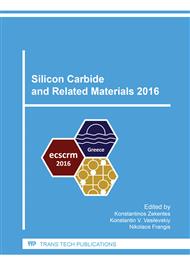[1]
M. Östling, Silicon Carbide Based Power Devices, in IEEE Electron Devices Meeting (IEDM), 2010, 13. 3. 1-13. 3. 4.
Google Scholar
[2]
T. Kimoto and J. A. Cooper, FUNDAMENTALS OF SILICON CARBIDE TECHNOLOGY. Wiley & Sons, 2014. Fig. 4. Measured and simulated reverse characteristics of the fabricated PiN diodes at room temperature.
Google Scholar
[3]
H. Niwa, G. Feng, J. Suda, and T. Kimoto, Breakdown Characteristics of 15-kV-Class 4H-SiC PiN Diodes With Various Junction Termination Structures, IEEE trans. Electron Devices 59 (2012) 2748.
DOI: 10.1109/ted.2012.2210044
Google Scholar
[4]
R. Ghandi, B. Buono, M. Domeij, G. Malm, C. -M. Zetterling, M. Ostling, High-Voltage 4H-SiC PiN Diodes With Etched Junction Termination Extension, IEEE Electron Device Lett. 30 (2009) 1170.
DOI: 10.1109/led.2009.2030374
Google Scholar
[5]
A. Salemi, H. Elahipanah, G. Malm, C. -M. Zetterling, and M. Östling, Area- and Efficiency-Optimized Junction Termination for a 5. 6 kV SiC BJT Process with Low, in Proc. IEEE 27th ISPSD, (2015) 249-252.
DOI: 10.1109/ispsd.2015.7123436
Google Scholar
[6]
A. Salemi, H. Elahipanah, B. Buono, C. -M. Zetterling, and M. Östling, Area-Optimized JTE Simulations for 4. 5 kV Non Ion-Implanted SiC BJT, Mater. Sci. Forum 740–742 (2013) 974–977.
DOI: 10.4028/www.scientific.net/msf.740-742.974
Google Scholar
[7]
H. Elahipanah, A. Salemi, C. Zetterling, M. Östling, Modification of Etched Junction Termination Extension for the High Voltage 4H-SiC Power Devices, Mater. Sci. Forum 858 (2016) 978-981.
DOI: 10.4028/www.scientific.net/msf.858.978
Google Scholar
[8]
B. A. Hulla, J. J. Sumakeris, M. K. Das, J. T. Richmond, and J. Palmour, Progress on the Development of 10 kV 4H-SiC PiN Diodes for HighCurrent/High Voltage Power Handling Applications, Mater. Sci. Forum 556–557 (2007) 895–900.
DOI: 10.4028/www.scientific.net/msf.556-557.895
Google Scholar
[9]
A. Salemi, H. Elahipanah, B. Buono, A. Hallen, J. U. Hassan, P. Bergman, G. Malm, C. M. Zetterling, and M. Ostling, Conductivity modulated on-axis 4H-SiC 10+ kV PiN diodes, Proc. Int. Symp. Power Semicond. Devices ICs, (2015) 269–272.
DOI: 10.1109/ispsd.2015.7123441
Google Scholar
[10]
S. Sundaresan, C. Sturdevant, M. Marripelly, E. Lieser, R. Singh, and G. Semiconductor, 12 . 9 kV SiC PiN diodes with low on-state drops and high carrier lifetimes, Mater. Sci. Forum 717–720 (2012) 949–952.
DOI: 10.4028/www.scientific.net/msf.717-720.949
Google Scholar
[11]
S. Sundaresan, M. Marripelly, S. Arshavsky, R. Singh, 15 kV SiC PiN diodes achieve 95% of avalanche limit and stable long-term operation, Proc. Int. Symp. Power Semicond. Devices ICs (2013) 175–177.
DOI: 10.1109/ispsd.2013.6694474
Google Scholar
[12]
H. Niwa, J. Suda, and T. Kimoto, 21. 7 kV 4H-SiC PiN diode with a Space-Modulated Junction Termination Extension, Appl. Phys. Express 5 (2012) 4–6.
DOI: 10.1143/apex.5.064001
Google Scholar
[13]
L. Lanni, B. G. Malm, M. Östling, and C. M. Zetterling, SiC etching and sacrificial oxidation effects on the performance of 4H-SiC BJTs, Mater. Sci. Forum 778 (2014) 1005–1008.
DOI: 10.4028/www.scientific.net/msf.778-780.1005
Google Scholar
[14]
L. Lanni, B. G. Malm, S. Member, and M. Östling, Influence of Passivation Oxide Thickness and Device Layout on the Current Gain of SiC BJTs, IEEE Electron Device Lett. 36 (2015) 11–13.
DOI: 10.1109/led.2014.2372036
Google Scholar
[15]
D. Stefanakis and K. Zekentes, TCAD models of the temperature and doping dependence of the bandgap and low field carrier mobility in 4H-SiC, Microelectron. Eng. 116 (2014) 65–71.
DOI: 10.1016/j.mee.2013.10.002
Google Scholar
[16]
A. O. Konstantinov, Q. Wahab, N. Nordell, and U. Lindefelt, Ionization Rates and Critical Fields in 4H SiC Junction Devices, Mater. Sci. Forum 264–268 (1998) 513–516.
DOI: 10.4028/www.scientific.net/msf.264-268.513
Google Scholar


